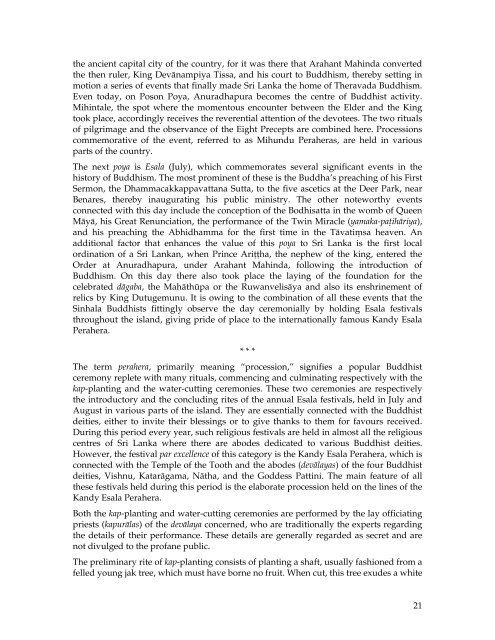Buddhist Ceremonies and Rituals of Sri Lanka
Buddhist Ceremonies and Rituals of Sri Lanka
Buddhist Ceremonies and Rituals of Sri Lanka
Create successful ePaper yourself
Turn your PDF publications into a flip-book with our unique Google optimized e-Paper software.
the ancient capital city <strong>of</strong> the country, for it was there that Arahant Mahinda converted<br />
the then ruler, King Devánampiya Tissa, <strong>and</strong> his court to Buddhism, thereby setting in<br />
motion a series <strong>of</strong> events that finally made <strong>Sri</strong> <strong>Lanka</strong> the home <strong>of</strong> Theravada Buddhism.<br />
Even today, on Poson Poya, Anuradhapura becomes the centre <strong>of</strong> <strong>Buddhist</strong> activity.<br />
Mihintale, the spot where the momentous encounter between the Elder <strong>and</strong> the King<br />
took place, accordingly receives the reverential attention <strong>of</strong> the devotees. The two rituals<br />
<strong>of</strong> pilgrimage <strong>and</strong> the observance <strong>of</strong> the Eight Precepts are combined here. Processions<br />
commemorative <strong>of</strong> the event, referred to as Mihundu Peraheras, are held in various<br />
parts <strong>of</strong> the country.<br />
The next poya is Esala (July), which commemorates several significant events in the<br />
history <strong>of</strong> Buddhism. The most prominent <strong>of</strong> these is the Buddha’s preaching <strong>of</strong> his First<br />
Sermon, the Dhammacakkappavattana Sutta, to the five ascetics at the Deer Park, near<br />
Benares, thereby inaugurating his public ministry. The other noteworthy events<br />
connected with this day include the conception <strong>of</strong> the Bodhisatta in the womb <strong>of</strong> Queen<br />
Máyá, his Great Renunciation, the performance <strong>of</strong> the Twin Miracle (yamaka-paþiháriya),<br />
<strong>and</strong> his preaching the Abhidhamma for the first time in the Távatiísa heaven. An<br />
additional factor that enhances the value <strong>of</strong> this poya to <strong>Sri</strong> <strong>Lanka</strong> is the first local<br />
ordination <strong>of</strong> a <strong>Sri</strong> <strong>Lanka</strong>n, when Prince Ariþþha, the nephew <strong>of</strong> the king, entered the<br />
Order at Anuradhapura, under Arahant Mahinda, following the introduction <strong>of</strong><br />
Buddhism. On this day there also took place the laying <strong>of</strong> the foundation for the<br />
celebrated dágaba, the Maháthúpa or the Ruwanvelisäya <strong>and</strong> also its enshrinement <strong>of</strong><br />
relics by King Dutugemunu. It is owing to the combination <strong>of</strong> all these events that the<br />
Sinhala <strong>Buddhist</strong>s fittingly observe the day ceremonially by holding Esala festivals<br />
throughout the isl<strong>and</strong>, giving pride <strong>of</strong> place to the internationally famous K<strong>and</strong>y Esala<br />
Perahera.<br />
* * *<br />
The term perahera, primarily meaning “procession,” signifies a popular <strong>Buddhist</strong><br />
ceremony replete with many rituals, commencing <strong>and</strong> culminating respectively with the<br />
kap-planting <strong>and</strong> the water-cutting ceremonies. These two ceremonies are respectively<br />
the introductory <strong>and</strong> the concluding rites <strong>of</strong> the annual Esala festivals, held in July <strong>and</strong><br />
August in various parts <strong>of</strong> the isl<strong>and</strong>. They are essentially connected with the <strong>Buddhist</strong><br />
deities, either to invite their blessings or to give thanks to them for favours received.<br />
During this period every year, such religious festivals are held in almost all the religious<br />
centres <strong>of</strong> <strong>Sri</strong> <strong>Lanka</strong> where there are abodes dedicated to various <strong>Buddhist</strong> deities.<br />
However, the festival par excellence <strong>of</strong> this category is the K<strong>and</strong>y Esala Perahera, which is<br />
connected with the Temple <strong>of</strong> the Tooth <strong>and</strong> the abodes (deválayas) <strong>of</strong> the four <strong>Buddhist</strong><br />
deities, Vishnu, Katarágama, Nátha, <strong>and</strong> the Goddess Pattini. The main feature <strong>of</strong> all<br />
these festivals held during this period is the elaborate procession held on the lines <strong>of</strong> the<br />
K<strong>and</strong>y Esala Perahera.<br />
Both the kap-planting <strong>and</strong> water-cutting ceremonies are performed by the lay <strong>of</strong>ficiating<br />
priests (kapurálas) <strong>of</strong> the deválaya concerned, who are traditionally the experts regarding<br />
the details <strong>of</strong> their performance. These details are generally regarded as secret <strong>and</strong> are<br />
not divulged to the pr<strong>of</strong>ane public.<br />
The preliminary rite <strong>of</strong> kap-planting consists <strong>of</strong> planting a shaft, usually fashioned from a<br />
felled young jak tree, which must have borne no fruit. When cut, this tree exudes a white<br />
21

















